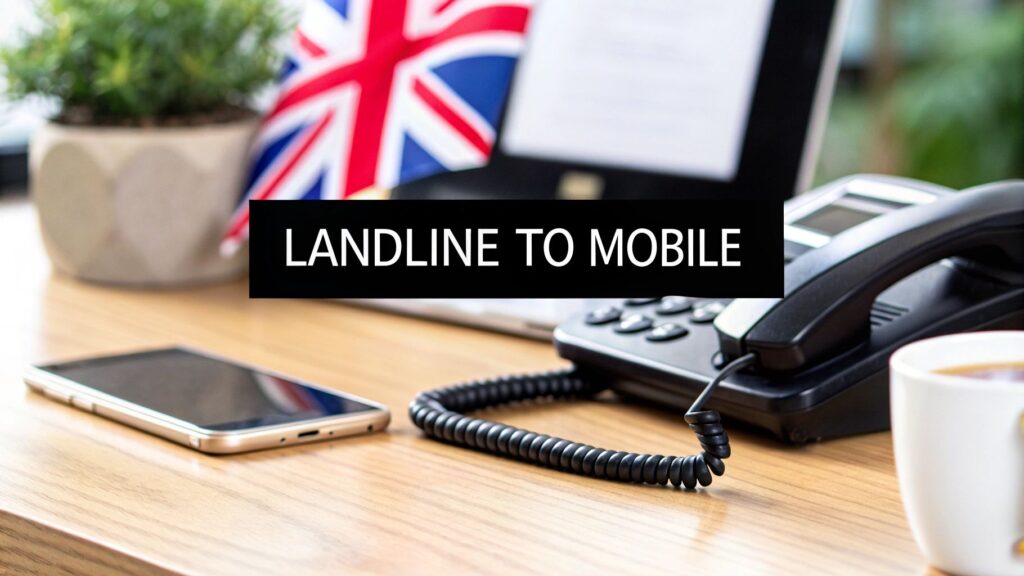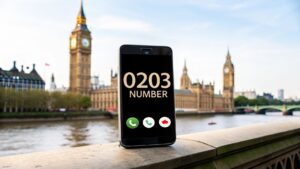Wondering how to forward your landline to your mobile? In many cases, it’s as simple as dialling a code like *21* from your landline phone, then entering your mobile number. Just like that, every call to your home or office number can be rerouted straight to your smartphone, meaning you never have to miss an important conversation again.
Why Forwarding Your Landline Still Matters
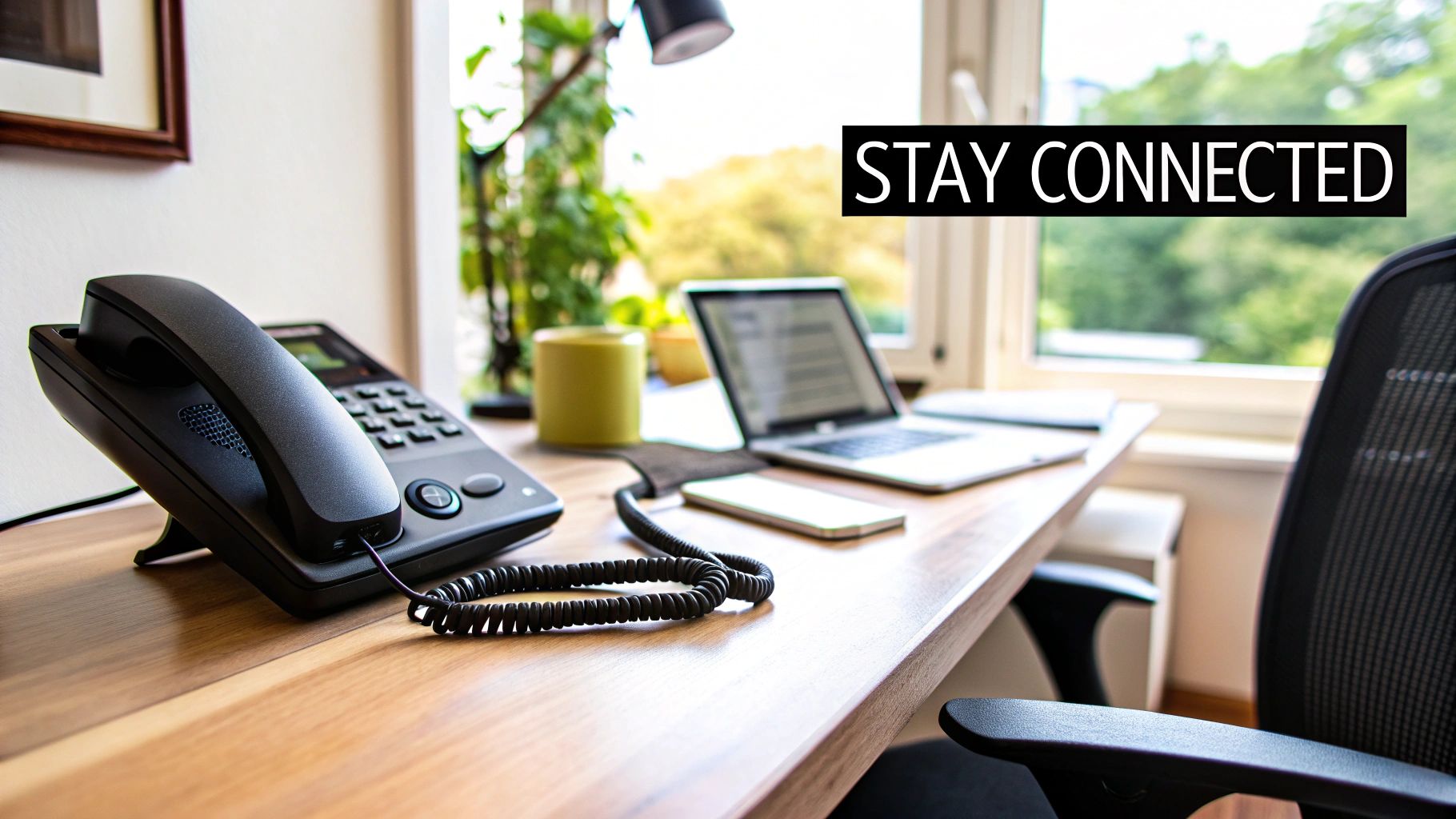
In a world practically glued to smartphones, it's easy to think of the landline as a bit of a relic. But for countless UK households and businesses, that familiar number is still a crucial link. Call forwarding isn't just a technical trick; it’s a smart way to bridge the gap between the reliability of a fixed line and the freedom of your mobile lifestyle.
Think about it from a practical standpoint. An elderly relative might only have your home number saved, and they need to reach you urgently while you're out. By forwarding your landline, their call rings on your mobile instantly. It's a simple setup that provides genuine peace of mind.
Keep Up a Professional Front
For freelancers, sole traders, and small business owners, a landline number can make a business seem more established and trustworthy. When a potential client dials your business number, they expect to speak to someone, not get a generic voicemail.
Diverting those calls to your mobile means you can answer professionally from anywhere—whether you're meeting a supplier, out on a job, or simply working from the kitchen table. It’s a game-changer for customer service and helps you seize every opportunity that comes your way.
The Clear Advantages of Call Forwarding
Setting up this feature delivers immediate benefits that blend pure convenience with a professional edge.
- Never Miss Important Calls: You can be confident that calls from clients, family members, or even the doctor's surgery will always find you, no matter where you are.
- Boost Your Professional Image: Keep the credibility of a local landline number, even if you’re always on the move and work entirely from your mobile.
- Work with More Flexibility: It untethers you from your desk. This freedom is essential for remote working and a modern lifestyle, all without sacrificing your main point of contact.
Knowing how to forward a landline to a mobile isn't just about rerouting calls. It’s about making your communication more robust and ensuring you're always reachable when it counts.
How to Set Up Call Forwarding Directly With Your Provider
The simplest way to get your landline calls ringing on your mobile is to set it up directly with your phone provider. This classic method uses what are often called 'star codes' – simple commands you dial from your landline handset to turn call forwarding on and off. It's wonderfully straightforward and puts you in complete control, with no need to wait in a queue for customer support.
You have a few choices for how the calls get diverted, which is great because you can tailor it to what you need. Whether you're just popping out of the office for a lunch meeting or you need a more permanent setup, there's a setting for it.
This quick diagram shows you exactly what happens behind the scenes. The call comes in, the network instantly catches it, and sends it straight over to your mobile.
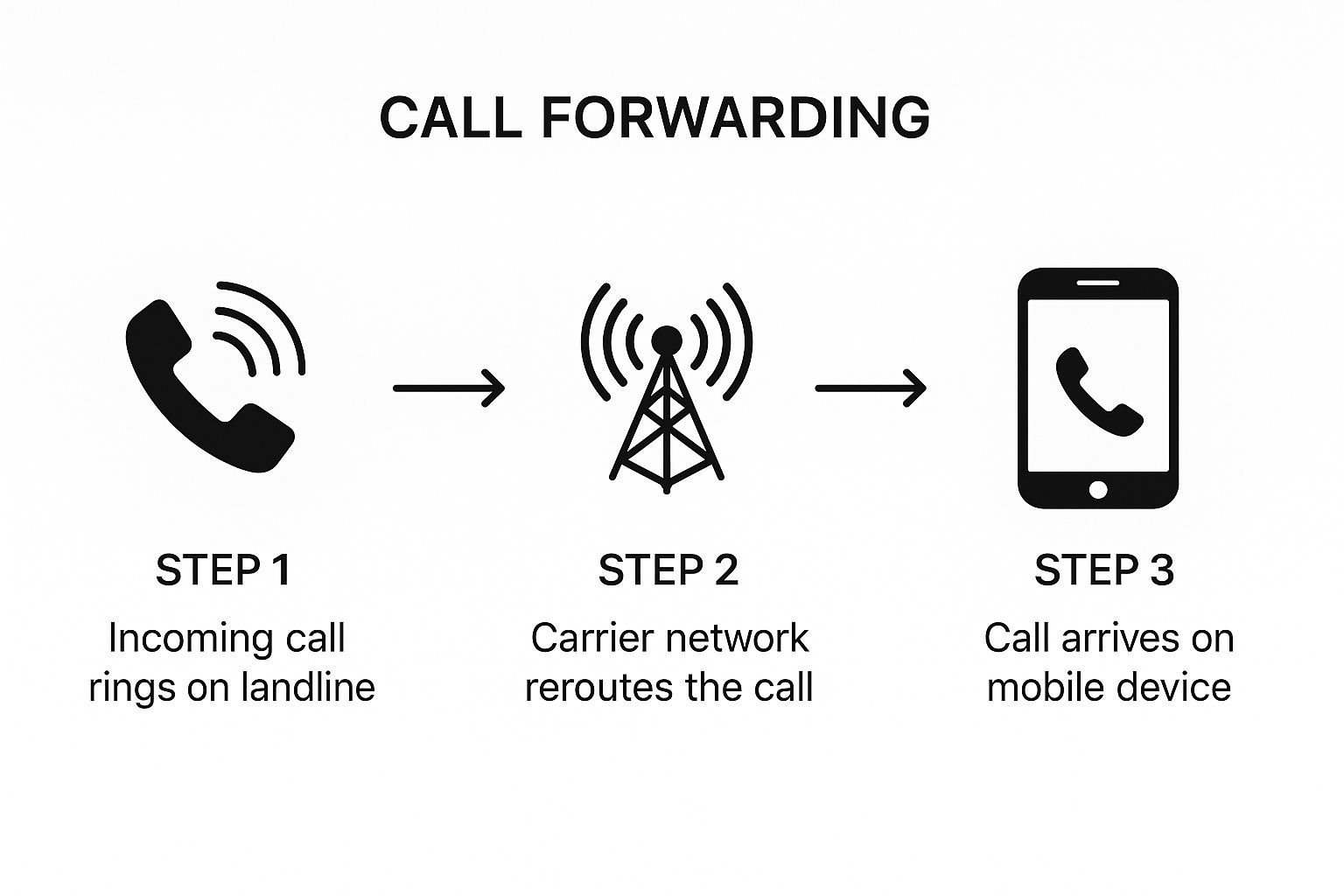
As you can see, the network does all the clever work, rerouting the call before your landline even gets a chance to ring more than once.
Getting to Grips With Your Options
Before you pick up the phone, it’s worth knowing the three main types of call forwarding you’ll come across:
- Forward All Calls: This is the one most people think of. Every single call to your landline is immediately sent over to your mobile. Perfect for when you know the office will be empty or you're away on holiday.
- Forward on No Answer: A handy backup. If you don't answer your landline after a few rings (usually around 15 seconds), the call then hops over to your mobile. This gives you a chance to grab the landline first if you happen to be there.
- Forward When Busy: If you're already on the phone, any new calls that come in are sent to your mobile instead of hitting a busy tone. This is brilliant for making sure you don't miss an important call just because you're already talking to someone else.
It's surprisingly easy to get going. For instance, to forward every call, you’d typically dial
*21*, enter the mobile number you want calls sent to, and then finish with the#key. It really is as simple as that.
A Quick Reference for UK Call Forwarding Codes
To make things even easier, here's a handy table with the most common codes for major UK landline providers. Remember to listen for a confirmation tone after entering the code to know it has worked.
| Service Provider | Forward All Calls (Activate) | Forward on No Answer (Activate) | Deactivate All Forwarding |
|---|---|---|---|
| BT | *21*(phone number)# |
*61*(phone number)# |
#21# |
| Virgin Media | *21*(phone number)# |
*61*(phone number)# |
#21# |
| TalkTalk | *21*(phone number)# |
*61*(phone number)# |
#21# |
| Sky | *21*(phone number)# |
*61*(phone number)# |
#21# |
Just remember to swap (phone number) with the actual mobile number you want to forward to. Deactivating is just as painless – a quick dial of the deactivation code and you're back to normal.
How to Activate It on UK Networks
While the activation codes are very similar, there can be slight differences between providers like BT, Virgin Media, and TalkTalk. The process is always the same, though: pick up your landline, dial the right code, and you’re done. Deactivating is just as simple, usually with a code like #21#.
Thankfully, setting this up is much more affordable than it used to be. In the past, the costs could be a real barrier. But thanks to regulatory nudges from Ofcom and a more competitive market, things have improved. By 2018, the average cost for these services had dropped by 25%, which has definitely encouraged more people and businesses to use them. If you're interested in the data, you can read more about the UK's evolving telecoms infrastructure on Statista.com.
Using VoIP for Smarter Call Management
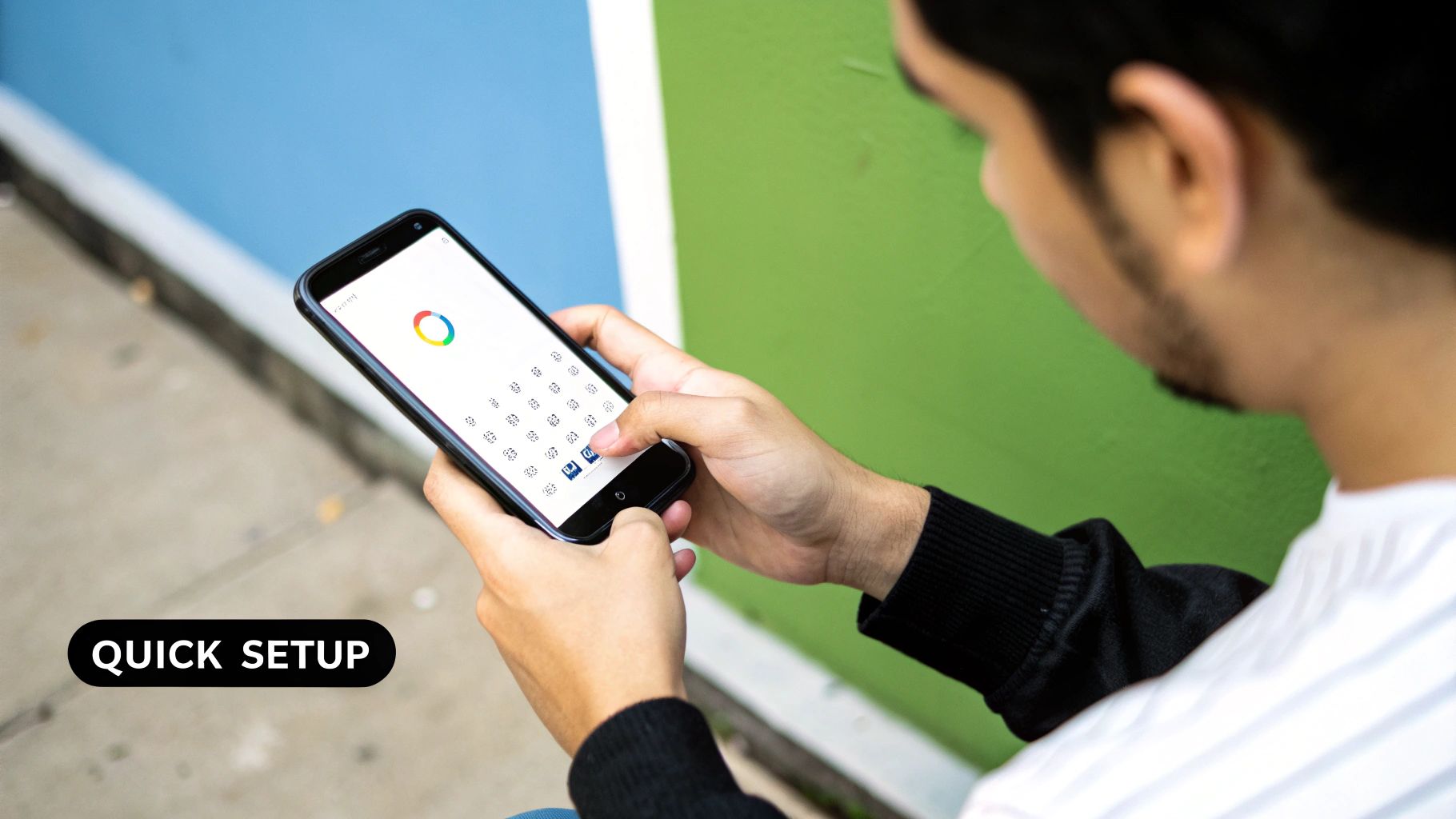
While basic call forwarding is a great quick fix, it's really just scratching the surface of what’s possible today. If you're looking for a more powerful and flexible way to forward your landline to a mobile, the modern solution is Voice over IP (VoIP). This technology essentially frees your number from its physical copper line, turning it into a "virtual" number you can manage from anywhere.
Think of it this way: instead of your number being stuck to a specific building, a virtual landline number exists in the cloud. You answer and manage every call through a simple app on your smartphone. This has been a massive shift for freelancers and small businesses who want to project a professional image without being chained to a desk. You can be on-site with a client or grabbing a coffee and still answer your "office" number – the person calling will never know you aren't at your desk.
Beyond Basic Call Forwarding
The real magic of a VoIP service, like the ones offered by Business Numbers Direct, comes from the advanced features that standard diverts just can't offer. You get an entire toolkit to run your communications like a much larger, more established company.
For example, you gain the ability to:
- Set Custom Business Hours: Automatically send calls to voicemail when you've clocked off for the day. It’s a simple way to help protect your work-life balance.
- Create Professional Greetings: Record a bespoke welcome message to greet every caller. This small touch instantly makes your business sound more organised and professional.
- Intelligent Call Routing: Direct calls to different team members based on the time of day or even menu options you set up, making sure the right person always gets the call.
With a virtual number, you're not just forwarding calls; you’re creating a smart communications hub. It’s about taking complete control over how, when, and where you handle your business calls, all from the device already in your pocket.
Ultimately, this approach turns your landline number from a simple contact point into a powerful business tool. It gives you a level of control that, not too long ago, was only available to big corporations with expensive phone systems.
Picking the Right Way to Forward Your Calls
So, how should you forward your landline to a mobile? It really boils down to what you’re trying to achieve. There’s no single "best" method for everyone; it’s about weighing up the simple, no-frills approach of your phone provider against the smarter, more flexible features of a modern VoIP system.
For many people, forwarding a call is just a temporary fix. Maybe you're waiting for a delivery or don't want to miss a call from a relative while you're out. In that case, the star codes offered by providers like BT or Virgin Media are more than enough. They’re quick, easy, and get the job done without any fuss.
But the moment your landline number is tied to your business, the game changes. If you’re a freelancer, a small business owner, or a consultant, you need more than a simple redirect. You need tools that make you look professional and help you work smarter. This is exactly where a VoIP solution, such as a virtual number from Business Numbers Direct, proves its worth.
When to Stick with Traditional Forwarding
The old-school method is perfect for personal, short-term needs. You should probably stick with your provider’s service if:
- You only need to divert your landline every now and then for personal calls.
- Your main goal is just to be reachable, without needing any fancy call management features.
- You’re happy to dial a few codes and don't require things like custom greetings or call menus.
When a VoIP Service is the Smarter Move
For anyone using their number for work, a VoIP service is hands-down the better option. It’s the right choice if:
- You want to keep your business and personal calls separate, even on the same mobile phone.
- You need professional features like a welcome greeting, defined business hours, or intelligent call routing.
- You need the freedom to answer your "office" line anywhere, projecting a professional image no matter your location.
At the end of the day, it's about what you need. Provider forwarding is a great quick fix, but a VoIP service is a proper long-term strategy for professional communications.
This need for better call handling isn't just a niche requirement; it's become mainstream. By 2020, an impressive 60% of active landline users had enabled call forwarding, a huge increase driven by our desire to blend the reliability of a fixed line with mobile freedom. This reflects a fundamental shift in how we manage our calls. You can dive deeper into these UK communication trends from the University of Oxford.
Take a moment to think about your own situation. Once you're clear on your needs, you can confidently pick the service that’s the perfect fit for you.
Why Forwarding Your Calls Makes Good Business Sense
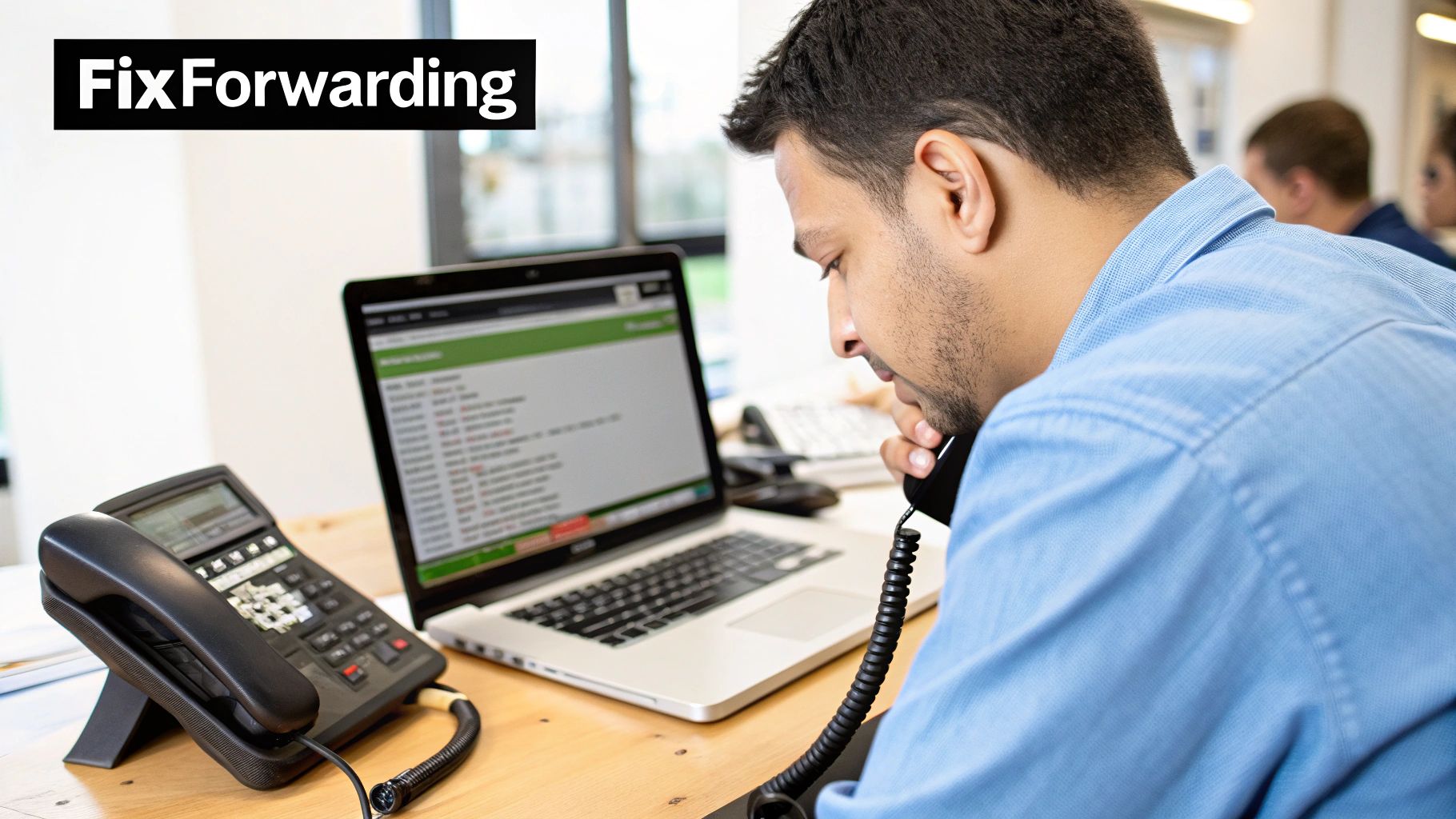
For any business in the UK today, being available for your customers isn't just a nice-to-have, it’s absolutely essential. The ability to forward a landline to a mobile has moved beyond a simple convenience. It’s a strategic tool that helps you stay agile and keep your customers happy.
Think about it in real-world terms. A self-employed plumber is out on a job, finishing an installation. A call comes through to their "office" landline, which rings directly on their mobile. It’s a new client with an emergency burst pipe – a valuable job they would have completely missed otherwise. This is exactly how small businesses stay competitive.
Or picture a consultant who wants to project a professional, city-based image with a prestigious landline number, but actually works from a home office miles away. Call forwarding makes that possible, building trust with clients while keeping overheads low. It’s all about being professional and present, no matter your physical location.
Keeping a Flexible Workforce Connected
With remote and hybrid work now standard practice, call forwarding is the essential link that keeps your team connected to your customers. It guarantees that regardless of where your staff are working from, your main business number remains the one reliable way for clients to reach you.
This isn’t just a feeling; the numbers confirm it. The huge shift to remote work forced businesses to find new ways to stay connected. In fact, research indicates that around 70% of UK SMEs now depend on call forwarding to ensure staff are reachable when they're not in the office. It was a lifeline that ensured business continuity for millions. If you're interested in how these trends have evolved, you can find out more from the Office for National Statistics.
By making sure every call is answered, you aren't just delivering good service. You are actively protecting your revenue and your reputation. In business, a missed call is almost always a missed opportunity.
At the end of the day, setting up call forwarding is a smart investment in your company's flexibility. It's a low-cost, high-impact move that brings real, measurable benefits like better customer satisfaction, a more polished image, and the agility you need to succeed.
Your Call Forwarding Questions, Answered
If you’re thinking about forwarding your landline to your mobile, you probably have a few questions. Let's clear up the most common ones to help you decide if it's the right move for you or your business.
Will I Have to Pay Extra for This?
This is often the first question, and the answer is: it depends entirely on your provider and the method you choose.
With traditional landline providers like BT or Virgin Media, you'll often find extra charges. This could be a monthly fee for the service, a connection fee for each forwarded call, or a per-minute rate. These costs can add up, especially for a busy business.
On the other hand, most modern VoIP providers, like Business Numbers Direct, include call forwarding as a standard part of their monthly plans. For a single, predictable fee, you get this feature included, which is usually a much more cost-effective way to go if you expect a decent number of calls.
Can People Tell Their Call is Being Diverted?
Nope, not at all. The entire process is designed to be completely invisible to the person calling you.
When someone dials your landline number, the switch happens instantly in the background. There are no strange clicks, long pauses, or automated messages announcing the forward. From their perspective, they've just dialled a landline and been connected. It's a totally seamless experience, which is vital for maintaining a professional image.
The beauty of a good call forwarding setup is its invisibility. The caller experiences a normal, direct connection, ensuring a smooth and professional interaction every single time.
Can I Divert My Landline to an International Number?
You absolutely can, but this is where you need to be very careful with costs.
Forwarding a call internationally with a traditional provider can get expensive, fast. They will likely charge you premium international rates for every call you receive this way. VoIP services are often a better bet here, but it's essential to check their international rate card first. The last thing you want is a surprise bill at the end of the month.
Ready to manage all your business calls from the freedom of your smartphone? Get a dedicated virtual number with Business Numbers Direct today and unlock professional features that help you grow. Learn more and sign up in minutes.

